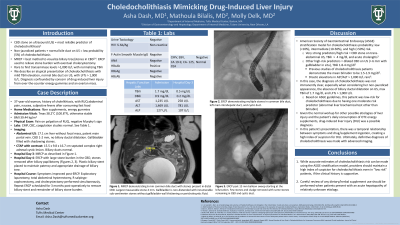Monday Poster Session
Category: Liver
P3001 - Choledocholithiasis Mimicking Drug-Induced Liver Injury
Monday, October 28, 2024
10:30 AM - 4:00 PM ET
Location: Exhibit Hall E

Has Audio

Asha Dash, MD
Tufts Medical Center
Boston, MA
Presenting Author(s)
Asha Dash, MD1, Mathoula Bilalis, MD2, Molly Delk, MD2
1Tufts Medical Center, Boston, MA; 2Tulane School of Medicine, New Orleans, LA
Introduction: The incidence of choledocholithiasis is rising in the United States. Strong predictors for choledocholithiasis risk are a common bile duct (CBD) stone on trans-abdominal ultrasound (US), a dilated CBD on US ( > 6 mm), and elevation of total bilirubin (TBili) > 1.8 mg/dl. Elevation of other liver serologies are less robust predictors of choledocholithiasis and isolated drastic elevations in transaminases above 1,000 U/L have rarely been reported. In this case, we describe an atypical presentation of choledocholithiasis in a patient with a normal US and predominant hepatocellular liver injury with transaminase elevations above 1,000 U/L. Given the unusual clinical presentation in this case, the diagnosis was confounded by the possibility of drug-induced liver injury (DILI) and the discovery of an ovarian mass.
Case Description/Methods: A 37-year-old woman with no significant past medical history presented with complaints of nausea and right upper quadrant (RUQ) abdominal pain. She denied any personal history of liver disease without risk factors for viral hepatitis or alcohol-associated liver disease. She did report regular consumption of energy supplements, but was not on any medications known to cause a liver injury. Her vitals were normal upon presentation. Labs revealed significantly elevated transaminases > 1,000 U/L and TBili of 1.7 mg/dl. US showed normal biliary ducts without dilation, cholelithiasis, and a sizable right adnexal lesion. With supportive measures, her TBili normalized with persistent elevation of her transaminases. An MRCP was performed and showed multiple stones in the distal common bile duct. She underwent an ERCP with sphincterotomy and stent placement, after which her transaminases improved.
Discussion: Based on the American Society for Gastrointestinal Endoscopy (ASGE) guidelines for choledocholithiasis, this patient fell into the low-risk category and had risk factors for alternative causes of a liver injury. A definitive diagnosis of choledocholithiasis was ultimately made by MRCP. In this case, the patient was a female with obesity and cholelithiasis on US, presenting with RUQ pain and nausea, increasing the pre-test probability of a diagnosis of choledocholithiasis. Furthermore, choledocholithiasis is known to occur in up to 20% of patients with cholelithiasis. Utilization of the clinical history in this case helped maintain a thorough differential diagnosis when the diagnostic studies were initially confounding.
Disclosures:
Asha Dash, MD1, Mathoula Bilalis, MD2, Molly Delk, MD2. P3001 - Choledocholithiasis Mimicking Drug-Induced Liver Injury, ACG 2024 Annual Scientific Meeting Abstracts. Philadelphia, PA: American College of Gastroenterology.
1Tufts Medical Center, Boston, MA; 2Tulane School of Medicine, New Orleans, LA
Introduction: The incidence of choledocholithiasis is rising in the United States. Strong predictors for choledocholithiasis risk are a common bile duct (CBD) stone on trans-abdominal ultrasound (US), a dilated CBD on US ( > 6 mm), and elevation of total bilirubin (TBili) > 1.8 mg/dl. Elevation of other liver serologies are less robust predictors of choledocholithiasis and isolated drastic elevations in transaminases above 1,000 U/L have rarely been reported. In this case, we describe an atypical presentation of choledocholithiasis in a patient with a normal US and predominant hepatocellular liver injury with transaminase elevations above 1,000 U/L. Given the unusual clinical presentation in this case, the diagnosis was confounded by the possibility of drug-induced liver injury (DILI) and the discovery of an ovarian mass.
Case Description/Methods: A 37-year-old woman with no significant past medical history presented with complaints of nausea and right upper quadrant (RUQ) abdominal pain. She denied any personal history of liver disease without risk factors for viral hepatitis or alcohol-associated liver disease. She did report regular consumption of energy supplements, but was not on any medications known to cause a liver injury. Her vitals were normal upon presentation. Labs revealed significantly elevated transaminases > 1,000 U/L and TBili of 1.7 mg/dl. US showed normal biliary ducts without dilation, cholelithiasis, and a sizable right adnexal lesion. With supportive measures, her TBili normalized with persistent elevation of her transaminases. An MRCP was performed and showed multiple stones in the distal common bile duct. She underwent an ERCP with sphincterotomy and stent placement, after which her transaminases improved.
Discussion: Based on the American Society for Gastrointestinal Endoscopy (ASGE) guidelines for choledocholithiasis, this patient fell into the low-risk category and had risk factors for alternative causes of a liver injury. A definitive diagnosis of choledocholithiasis was ultimately made by MRCP. In this case, the patient was a female with obesity and cholelithiasis on US, presenting with RUQ pain and nausea, increasing the pre-test probability of a diagnosis of choledocholithiasis. Furthermore, choledocholithiasis is known to occur in up to 20% of patients with cholelithiasis. Utilization of the clinical history in this case helped maintain a thorough differential diagnosis when the diagnostic studies were initially confounding.
Disclosures:
Asha Dash indicated no relevant financial relationships.
Mathoula Bilalis indicated no relevant financial relationships.
Molly Delk indicated no relevant financial relationships.
Asha Dash, MD1, Mathoula Bilalis, MD2, Molly Delk, MD2. P3001 - Choledocholithiasis Mimicking Drug-Induced Liver Injury, ACG 2024 Annual Scientific Meeting Abstracts. Philadelphia, PA: American College of Gastroenterology.
